Roman Gods
mapuo
The Dii Consentes, also known as Di or Dei Consentes (once Dii Complices), is an ancient list of twelve major deities, six gods and six goddesses, in the pantheon of Ancient Rome. Their gilt statues stood in the Roman Forum, and later apparently in the Porticus Deorum Consentium.
The gods were listed by the poet Ennius in the late 3rd century BCE in a paraphrase of an unknown Greek poet:
Juno, Vesta, Minerva, Ceres, Diana, Venus
Mars, Mercurius, Iovis, Neptunus, Vulcanus, Apollo
Livy arranges them in six male-female pairs: Jupiter-Juno, Neptune-Minerva, Mars-Venus, Apollo-Diana, Vulcan-Vesta and Mercury-Ceres. Three of the Dii Consentes formed the Capitoline Triad: Jupiter, Juno and Minerva.
Jupiter

Jupiter, the “Sky Father,” was the king of the Roman gods and the champion of Rome and its empire. Ruler of the heavens and overseer of battles, worshipers sought his favor by making sacrifices in his honor.
The supreme deity of the Roman pantheon, mighty Jupiter was a god of sky and thunder whose symbols were the oak tree and eagle. He ruled as the dominant member of a triumvirate called the Capitoline Triad, which included his consort Juno and daughter Minerva. Jupiter bore many similarities to Zeus, the king of the Greek deities from whom he was adapted.
Unlike Zeus, however, Jupiter was explicitly linked to a specific political entity—Rome. From the great temple erected in his honor on the Capitoline Hill in Rome, Jupiter presided over the state and its ever-expanding empire. As a result, the Romans emphasized the worship of Jupiter above all other gods. Jupiter’s blessings were thought to secure their victories and maintain hegemony over their rivals. Worship of Jupiter was formalized by the Roman state over the course of its existence.
What is known of Jupiter’s mythos came not through the narratives in which he plays a role, but from the ways in which his worship was observed by the Romans. Like other figures in Roman mythology, Jupiter was believed to be a critical actor in Roman history. Accordingly, his nature and attributes transformed in order to keep up with broader historical changes in the Roman state. By the end of the first century BCE, Jupiter’s centrality to the state was eclipsed by cults devoted to the worship of deified emperors.
Juno

Juno was the queen of the Roman gods, the champion of women in their domestic roles of marriage and motherhood. A jealous wife, she was always seeking to punish her husband Jupiter’s conquests.
The Roman goddess of marriage, home, and family, Juno was a champion of women and protector of the Roman state. She was married to Jupiter, king of all the gods, and served as a part of the divine ruling triumvirate known as the Capitoline Triad. Juno was adapted from the Greek goddess Hera, and her essential characteristics and mythology were nearly identical to her Greek predecessor.
Juno was among the first Roman gods and goddesses, and like her counterpart deities was thought to oversee both the private affairs of her worshipers and the affairs of the Roman state. According to the time and place of her worship, she embodied several distinct personae. She was “Mother”, “Midwife”, “Queen”, and “Light Bringer.” She was also considered a moon goddess, likely for her association with the waxing and waning of the celestial body, which in turn symbolized the cycles of growth and decay that defined all of existence.
The fluidity of her identity made her one of the most broadly worshiped Roman deities, as is evidenced by the huge number of temples built in her honor and festivals held in her name. Though she remained a beloved figure for centuries, Juno’s importance began to wane with the advent of the Roman Empire in the first century BCE.
Neptune
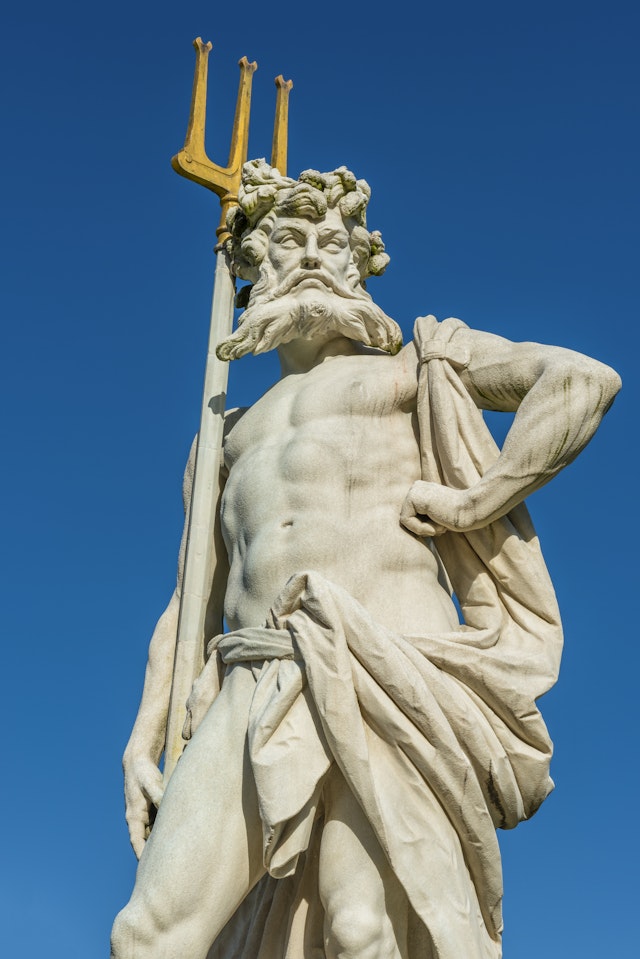
Neptune was the Roman god of all waters, bringer of winds and commander of storms. As capricious as the seas he commanded, Neptune guided the Roman people’s ancestor Aeneas to freedom, but demanded a human sacrifice for his assistance.
Neptune was the Roman god of waters and seas, who controlled winds and storms. Also known as Neptunus Equester, he was recognized as a god of horses and horsemanship, as well as patron of horse racing, a popular form of entertainment for the ancient Romans. In terms of his characteristics and mythology, Neptune was an exact copy of the Greek deity Poseidon.
Unlike Poseidon, who had been part of Greek mythology from the onset, Neptune was a later addition to the Roman pantheon. Whereas Poseidon’s subjects treated him as a kind of second-in-command to Zeus, Neptune was never a ruling deity. He was not represented in either the Archaic Triad of Jupiter, Mars, and Quirinus (the deified figure of Romulus, the founder of Rome) or the Capitoline Triad of Jupiter, Juno, and Minerva.
Though he lacked political power within the Roman pantheon, Neptune still commanded the fear and respect of a people whose fortunes were intimately tied to the seas. His importance increased in the second and third centuries BCE as Roman hegemony spread throughout the Mediterranean. As with other Roman deities, Neptune’s importance diminished in the early centuries of the Common Era, and fell completely out of favor with the advent of Christian dominance over the Roman Empire in the fourth century.
Minerva
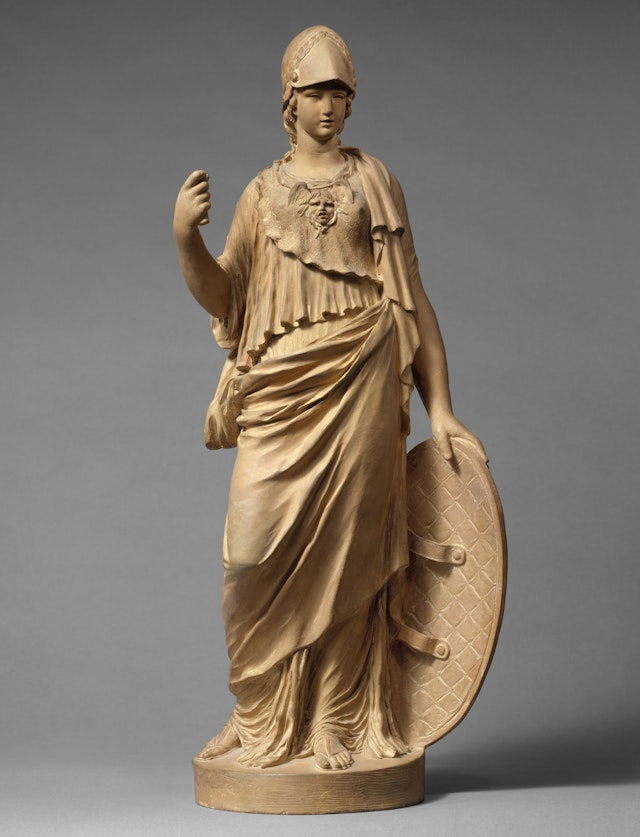
Minerva was the wisest of the Roman pantheon, the patron deity of philosophy, craftsmanship, art, and strategy. A quintessentially Roman goddess, she was part of the widely worshiped Capitoline Triad, along with Jupiter and Juno.
The wisest of the Roman deities, Minerva was a goddess of intelligence, philosophy, craftsmanship, art, and inspiration. From her position in the heavens, she oversaw all things that required forethought and calculation. In later incarnations, Minerva was also seen as a military figure, as well as the fount through which all strategic and tactical thought flowed. Minerva ruled with Jupiter and Juno as part of the divine triumvirate known as the Capitoline Triad.
Minerva may well be the most quintessentially Roman of all Roman deities. Unlike Jupiter and Neptune, who were borrowed wholesale from Greek deities, Minerva evolved from an Etruscan deity known as Menrva. She was gradually Hellenized in the fourth and third centuries BCE, and took on more of Athena’s characteristics as the Romans took on more trappings of Greek civilization. During the same period, Minerva overtook Mars’ position in the Archaic Triad (composed of Jupiter, Quirinus, and Mars), forming the new Capitoline Triad. Her displacement of the raging war god Mars suggested a significant shift in Roman self-understanding and underscored its transition from provincial Italian power to Mediterranean superpower.
Revered by craftsmen, merchants, statesmen, military leaders, artists, and philosophers alike, Minerva was a central figure in the Roman mythos. Temples dedicated to Minerva were plentiful throughout the Roman Empire, and several festivals were held each year in her honor. As with other Roman deities, the worship of Minerva was eclipsed by the rise of Christianity, which came to dominate Roman hearts and minds in the fourth century CE.
Mars
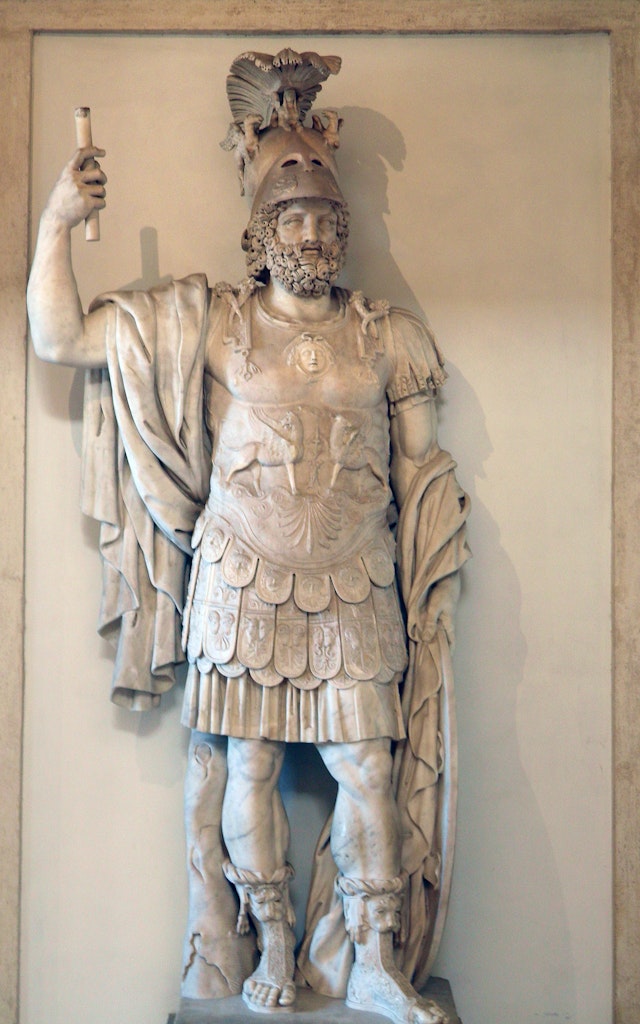
Mars was the raging Roman god of warfare whose fury inspired savagery in battle. Father of city founders Romulus and Remus, Mars was revered not only as a god of war, but one whose conflicts brought about lasting peace.
Furious Mars was the Roman god of rage, passion, destruction, and war. As a foundational deity, Mars had a mythology that was intimately intertwined with the Roman city-state. Mars ruled early Rome as a part of the Archaic Triad, a masculine ruling triumvirate that also included Jupiter and Quirinus (the deified Romulus). The early Romans revered Mars as a great raging god, whose fury inspired the savagery of warfare and produced the stunning accomplishments of the Roman arms. As Rome transitioned from city-state to empire and overtly embraced Greek cultural values, Mars lost his preeminent position in the Roman pantheon to Minerva, the goddess of tactical and strategic warfare.Mars’ importance to the Roman people was embedded in the mythic history of Rome and the origins of the Roman state. According to Roman mythology, Mars raped the innocent Rhea Silvia and sired Romulus and Remus, twins who would go on to establish the fabled city.
Mars was largely based on the Greek god Ares, the Greek god of war, and shared much of his mythology. The two deities differed in at least one respect, however—while Ares was a source of destructive conflicts that tore apart communities, Mars was a wellspring of productive conflicts that brought lasting peace.
Venus
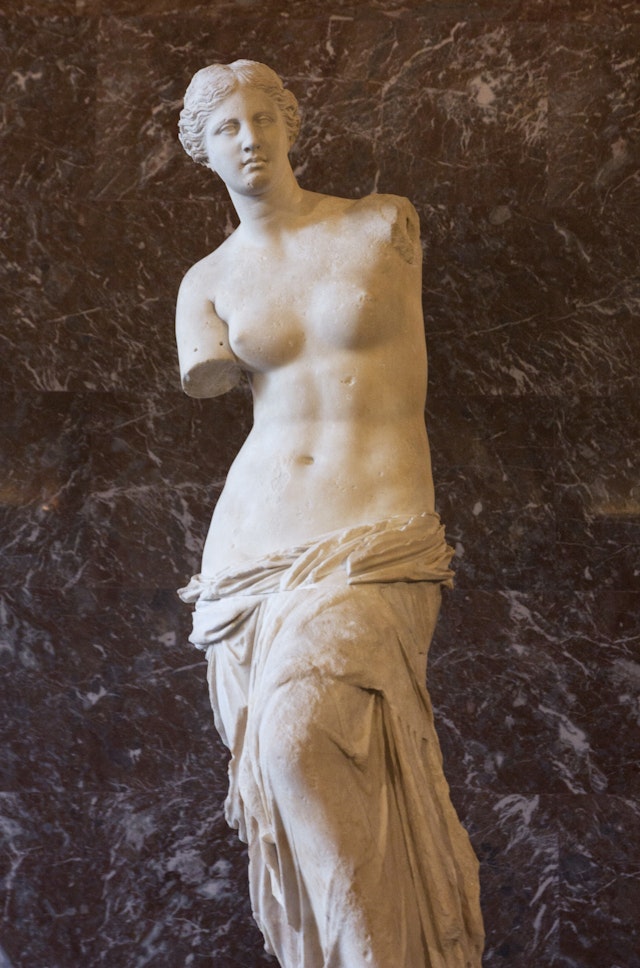
Venus was the Roman goddess of love, sex, maternal affection, and erotic passion. Incomparably beautiful, she was the guardian of lovers and prostitutes, and revered as the mother of Aeneas, founder of the Roman people.
Venus was the Roman goddess of love, maternal care, sexual reproduction, and erotic desire. The loveliest of all deities, Venus desired—and was desired by—mortals and gods alike. Like the Greek Apollo, Venus had a fluid sexuality and embraced male and female lovers alike. She was also the guardian of lovers and prostitutes, and a major figure in Roman religion. Venus was adapted from the Greek goddess Aphrodite, with whom she shared a mythological tradition.
Venus was formally incorporated and adopted into the Roman pantheon in the third century BCE. During the Punic Wars of the second and third centuries BCE, Venus was thought to lend her assistance to the Romans and ensure their victories over the Carthaginians. Her importance as a figure of worship peaked shortly thereafter, though she continued to be venerated until the rise of Christianity in the fourth century CE. Revered for bringing victory to the Romans, Venus was also celebrated as the mother of Aeneas, the ancestor of Romulus, the founder of Rome. In later years, Julius Caesar publicly linked his family’s heritage to the goddess’ maternal line, making Venus the progenitor of the first imperial dynasty.
Apollo

Apollo was the Roman god who inspired prophecy, poetry, music, and medicine. Incorporated directly from the Greeks after a plague devastated Rome, he was both the bringer of and guardian against pestilence.
Borrowed directly from Greek mythology, Apollo was a Roman god that inspired music, poetry, and artistic creativity. A law-giver and healer, Apollo brought order to humankind and was the source of all medical knowledge. Furthermore, Apollo served as the chief patron of prophets, the source of the gift of prophecy. He was thought to reside at Delphi, the center of oracular thought in the ancient Mediterranean.
While the Romans almost always adopted their deities from Greek and Etruscan counterparts, they typically took the effort to Romanize them. Apollo bucked this trend, however, retaining his status as a foreigner and an outsider; as such, his original mythology remained largely unchanged. Apollo’s incorporation into Roman mythology underscored the Romans’ conception of themselves as the rightful inheritors of Greek culture.
Despite his foreignness, Apollo was much beloved by the Romans, who viewed him as a source of political stability and medical knowledge, as well as a guardian against infectious disease.
Diana

Diana was the Roman goddess of the hunt, unspoiled nature, and the boundaries separating wild from civilized, living from dead. Master of the bow, she roamed the wilderness seeking adventure and hunting game.
Diana was the Roman goddess of the hunt, unspoiled nature and the animals that inhabited it. Shunning the company of mortals and gods, Diana preferred the solitude of the forests and kept the company of nymphs and woodland creatures. A master of the bow, Diana was the greatest of all hunters. A maiden for all her days, she preserved her virginity despite the advances of potential lovers and suitors. Diana was also associated with the underworld and liminal zones—the boundaries separating the living from the dead and the wild from the civilized. Though she was a Roman goddess, much of Diana’s mythology and personality originated elsewhere. Diana was heavily based on Artemis, the Greek goddess of hunting and nature.
Originally worshipped by the pre-Roman people of Italy, Diana eventually took on a more Hellenized form. She was incorporated into the Roman pantheon sometime during the sixth century BCE. In Roman religion, Diana was known as Diana Triformis, or a goddess of three aspects: the hunt, the moon, and the underworld. She was also a member of a divine triumvirate alongside Egeris, the water nymph, and Virbius, the woodland god. Adored by males and females alike, Diana was seen as a patron of hunters and protector of virgins.
Vulcan

Vulcan was the clever and crafty Roman god of the forge, master of blacksmiths and artisans. Lamed from childhood, he dedicated himself to his craft, creating some of the most powerful artifacts in Roman mythology.
The master of metallurgy and handicraft, Vulcan was the Roman god of fire and forge, as well as the patron of artisans and smiths. Known as the ugliest of the gods, Vulcan suffered from lameness in one leg due to an injury he sustained as a child. The patron of craftsmen was exceedingly crafty himself and used his guile to marry Venus, the goddess of love and sexual desire. As with many Roman deities, Vulcan was a near identical copy of his Greek equivalent: Hephaestus.
A storied member of the Roman pantheon, Vulcan was originally adapted from an Etruscan deity known as Sethlans. This version of Vulcan was later Hellenized and given most of the trappings of Hephaestus; Vulcan’s mythological tradition was largely similar to that of his Greek counterpart.
Vesta
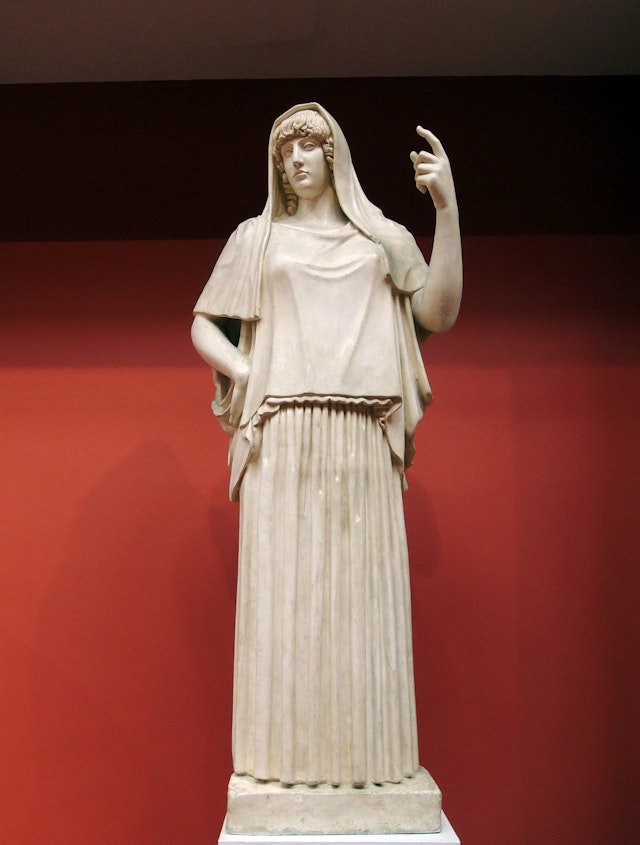
Vesta was the virginal Roman goddess of hearth and home, family life and child-rearing. A popular and uncontroversial deity, her enormous power over domestic tranquility ensured all prayers began and ended with devotions to her.
The goddess of the hearth and home, Vesta was a Roman deity that symbolized faith, family, and domestic order. Often known simply as Mater, or “Mother,” Vesta was recognized as the purest of Roman deities. An eternal virgin, Vesta inspired her priestesses, known as the Vestales (or Vestal Virgins), to adhere to a strict code of celibacy. Vesta was adapted from the Greek deity Hestia, with whom she shared many characteristics.
A leading deity in the Roman pantheon, Vesta was a truly ancient deity with a history that could be traced back to the founding of Rome itself. Though she was beloved by all common people, she had a special relationship with women, who unlike men were allowed access to her temple in the Roman Forum. Vesta was also a patron to millers and bakers. She was often represented by the donkey, which turned the millstone, and the kettle, which provided nourishment. Vesta was largely seen as an uncontroversial figure who seldom engaged in the drama that defined so much of the Roman pantheon. As a result, she was usually absent from Roman mythology’s more colorful tales.
Mercury

Mercury was the wily trickster of the Roman pantheon, patron deity of commerce and travel as well as messengers and thieves. Always pushing boundaries, he was as quick to fool the other gods as he was to offer them assistance.
Awily trickster, Mercury was the Roman god of commerce, communication, and travel. The patron of thieves, messengers, and merchants, he was also responsible for conveying souls to the underworld. As the chief messenger of the gods, Mercury controlled the flow of information, and often used this position to his advantage.
Like Hermes, the Greek god on whom he was based, Mercury challenged moral (and physical) boundaries. He was often nude, and was the only god in the Roman pantheon who could freely cross into the underworld. He possessed a winged helm that allowed him to fly and carried the potent caduceus, a wand with serpents wrapped around it; this latter symbol was frequently confused with the Rod of Asclepius.
Though Mercury did not join the Roman pantheon until the third century BCE, he nevertheless became a major figure in Roman religion. Because of his likeness to deities of other Mediterranean and European groups, Mercury was easily assimilated into cultures that were conquered by the Romans.
Ceres

Ceres was the Roman goddess of fertility and agriculture, the patron of farmers and protector of commoners. Festivals in the goddess’s honor sought her blessing for their crops to ensure a bountiful harvest.
The Roman goddess of fertility and agriculture, Ceres was the patron of farmers and protector of the plebeians. Adapted from the Greek deity Demeter, Ceres was worshiped as the mother of Proserpina, whose abduction by Pluto was a central episode in Greek and Roman mythologies. In the early days of Rome, Ceres was the chief member of the “plebeian” Aventine Triad, a cult of three deities worshiped by the common folk. The Triad's humble facilities on the Aventine Hill stood in marked contrast to the palatial grandeur that marked the nearby Capitoline Hill.
Ceres was the patron and protector of farmers, pastoralists, and plebeians; she was also the overseer of the elected officials known as the tribunes. Ceres offered her personal guidance to the “Tribune of the Plebeians,” a powerful magistrate that held the power to veto the decisions of the consul. The Tribune also enjoyed sacrosanctity, a status imparted by Roman sacred law making it illegal and heretical to harm its bearer. She was, then, the ultimate deity of the common people of Rome, whose bounty was thought to nourish even the humblest of Romans. The common folk lavished praise upon the golden goddess, and celebrated her at a number of festivals throughout the year. These festivals generally took place during the sowing and harvest seasons.
Log In
Nonethewiser
Fantastic job and many thanks!
Added this to the index of
Mythology / Folklore
ideas on this site.